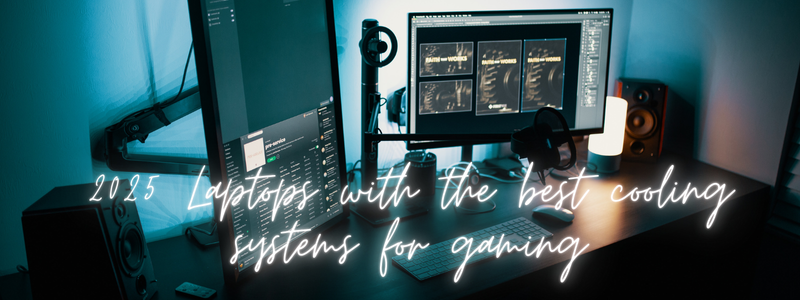Table of Contents

Introduction (2025 Laptops with the best cooling systems for gaming)
In 2025 Laptops with the best cooling systems for gaming in market has seen significant advancements in thermal management, addressing the increasing demands of high-performance hardware. Manufacturers have introduced innovative cooling technologies to ensure sustained performance during intensive gaming sessions. Among the standout models, the.
- Lenovo Legion Pro 7i,
- MSI Raider 18 HX AI, and
- ASUS ROG Strix Scar 16
Lenovo Legion Pro 7i

2025 Laptops with the best cooling systems for gaming is the Lenovo Legion Pro 7i stands out with its Legion Cold front 5.0 cooling system, which features dual fans, a vapor chamber, and liquid metal thermal paste. This combination effectively dissipates heat, maintaining optimal performance even during extended gaming sessions. The laptop’s chassis design facilitates improved airflow, ensuring that the internal components remain cool and efficient. Additionally, the inclusion of up to 64GB DDR5 RAM and an NVIDIA RTX 4080 GPU further enhances its gaming capabilities, making it a top choice for gamers seeking both power and thermal efficiency
MSI Raider 18 HX AI

2025 Laptops with the best cooling systems for gaming is MSI Raider 18 HX AI features a robust cooling system designed to handle the heat output of its high-performance components. The laptop is equipped with multiple fans and heat pipes that work in tandem to dissipate heat effectively. This design ensures that the CPU and GPU maintain optimal temperatures, even under heavy loads. The advanced cooling system not only enhances performance but also contributes to the laptop’s longevity by preventing thermal throttling and component degradation.
ASUS ROG Strix Scar 16

The ASUS ROG Strix Scar 16 incorporates an advanced cooling solution that includes a vapor chamber and liquid metal thermal paste. These technologies work together to efficiently transfer heat away from critical components, maintaining high performance during intense gaming sessions. The laptop’s design also includes strategically placed vents and heat sinks that further enhance airflow and cooling efficiency. This comprehensive thermal management system ensures that the laptop operates at peak performance without overheating, even during extended gaming sessions

🔧 Predicted Features of 2025 Gaming Laptops with Best Cooling Systems
1. Advanced Phase-Change Materials (PCMs)
By 2035, laptops are likely to use PCMs that change states (solid to liquid or gas) to absorb and dissipate heat more efficiently than today’s heat pipes and vapor chambers. These materials could provide rapid thermal response and reduce reliance on active cooling.
2. AI-Powered Dynamic Cooling
AI will likely manage fan speeds, thermal zones, and power distribution in real time. Systems will adjust instantly based on workload, ambient temperature, and historical usage patterns, improving both performance and acoustics.
3. Graphene-Based Heat Spreaders
Graphene, known for its extraordinary thermal conductivity, may become a common material for internal heat spreaders, significantly increasing thermal efficiency and enabling slimmer chassis designs without thermal compromise.
4. Liquid Cooling Integration
Miniaturized liquid cooling systems might be built directly into the laptop body, including self-contained, sealed loops with pumps and radiators. These systems will likely operate silently and cool both CPU and GPU without requiring massive fans.
5. Smart Thermal Zoning
Future laptops will have zone-specific cooling—cooling the keyboard, GPU, VRMs, and SSDs differently based on where heat is most intense. This will help prevent localized overheating and improve lifespan.
6. Vapor Chamber 2.0
Next-gen vapor chambers could include micro-structured surfaces and multi-phase heat transfer for near-instant dissipation. Some high-end models might feature full-cover vapor chambers that also cool RAM and storage.
7. Nanotechnology Coatings
Components could be treated with thermal-enhancing nano-coatings that reduce heat build-up and improve dissipation speed at the micro level.
8. Eco-Friendly Passive Cooling
Solid-state cooling systems, like thermoelectric cooling (TEC), may reduce moving parts, making laptops quieter and more eco-friendly. These systems convert electricity into heat differentials and could replace fans in ultra-premium models.
9. Modular Cooling Systems
Gamers might be able to swap out or upgrade cooling modules (fans, chambers, liquid coolers) depending on their usage needs, similar to how desktops are upgraded today.
10. Augmented Reality (AR) Cooling Monitors
Visual overlays through AR could allow users to monitor thermal hotspots in real-time, helping fine-tune cooling preferences or external fan placement.
Comparison and Conclusion
When comparing these models, the Lenovo Legion Pro 7i offers a balanced approach with its effective cooling system and powerful hardware. The MSI Raider 18 HX AI excels in handling high-performance components, ensuring sustained performance under heavy loads. Meanwhile, the ASUS ROG Strix Scar 16 provides an efficient cooling solution that maintains high performance during intense gaming sessions. Each of these laptops demonstrates the importance of advanced cooling technologies in delivering optimal gaming experiences.
In conclusion, the advancements in cooling technologies in 2025 gaming laptops have significantly improved performance and longevity. Models like the
Lenovo Legion Pro 7i,MSI Raider 18 HX AI, and ASUS ROG Strix Scar 16 exemplify the industry’s commitment to providing gamers with powerful and reliable machines. These innovations ensure that gamers can enjoy immersive experiences without compromising on performance or hardware longevity.
